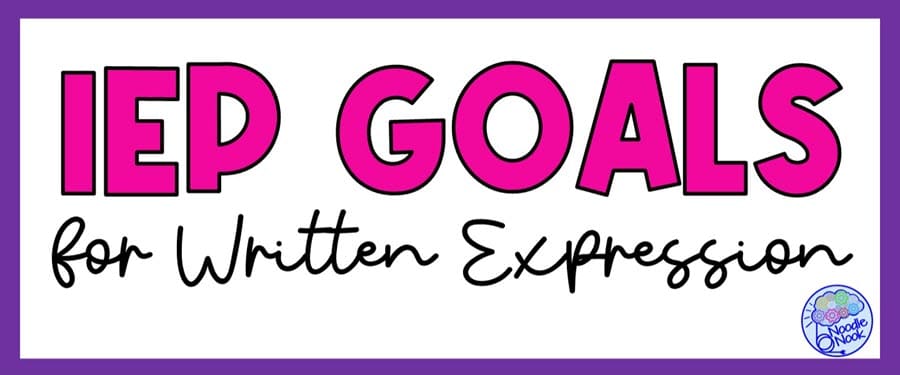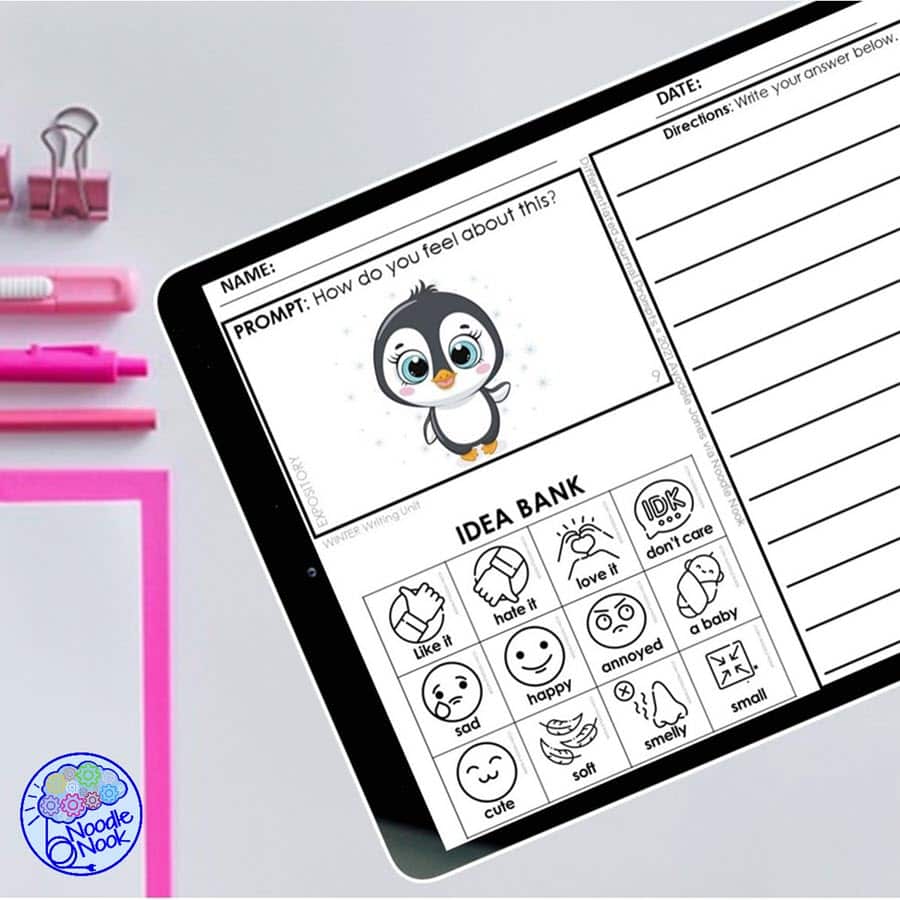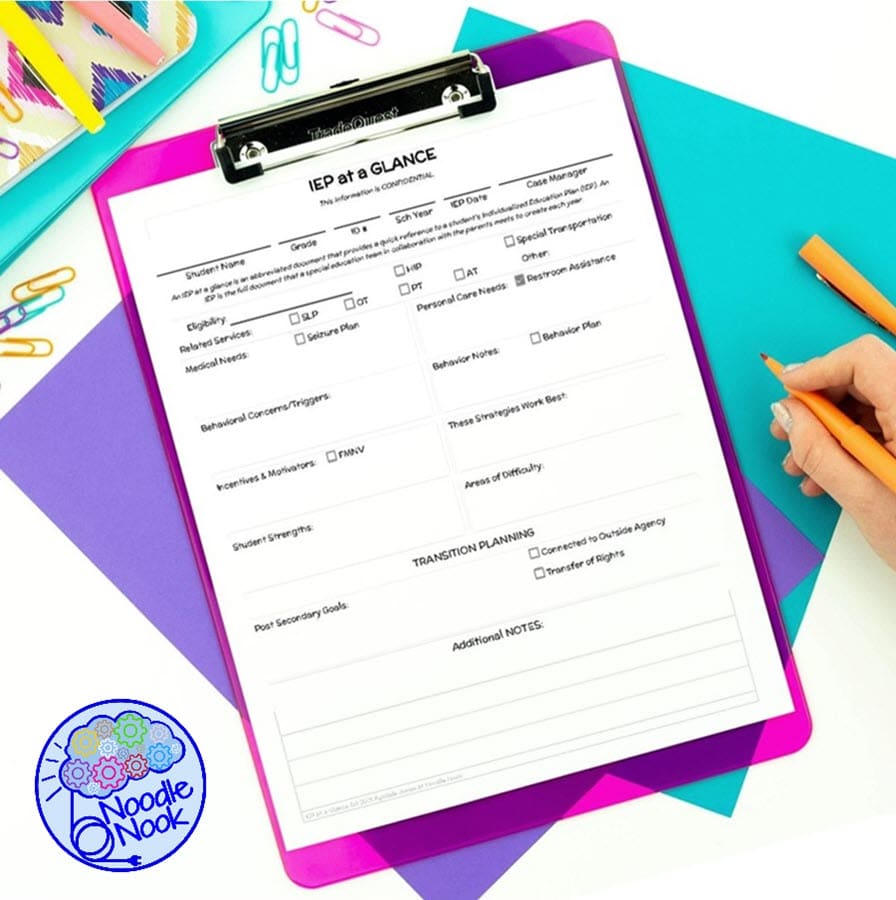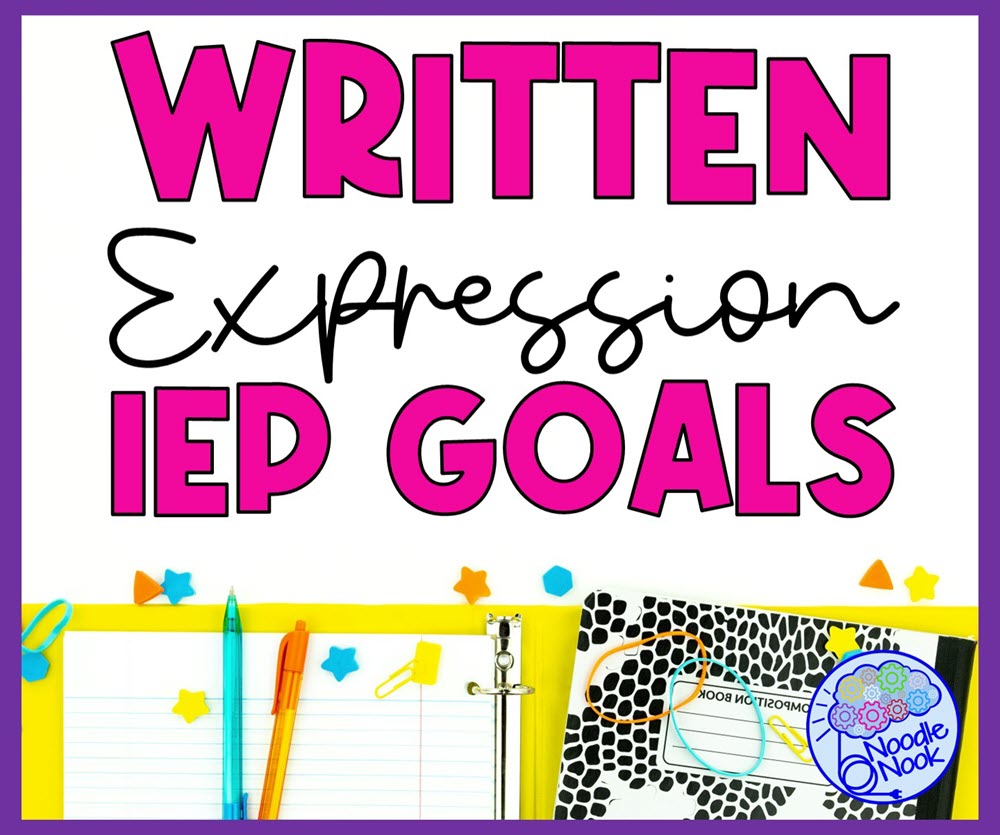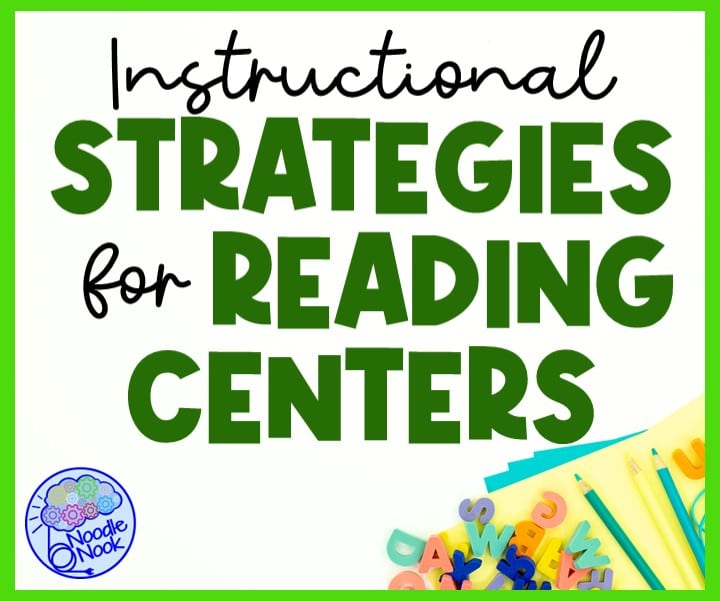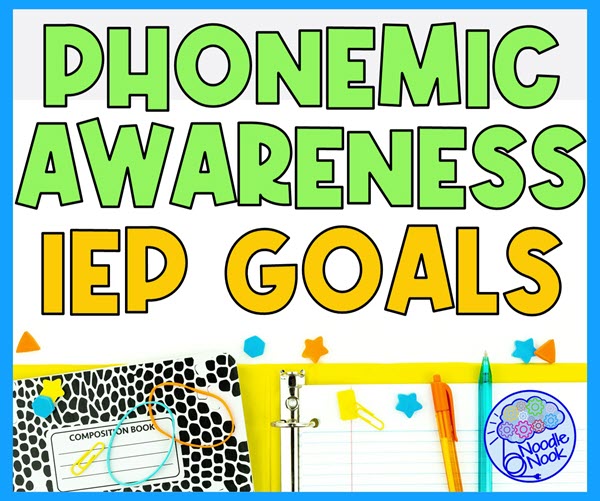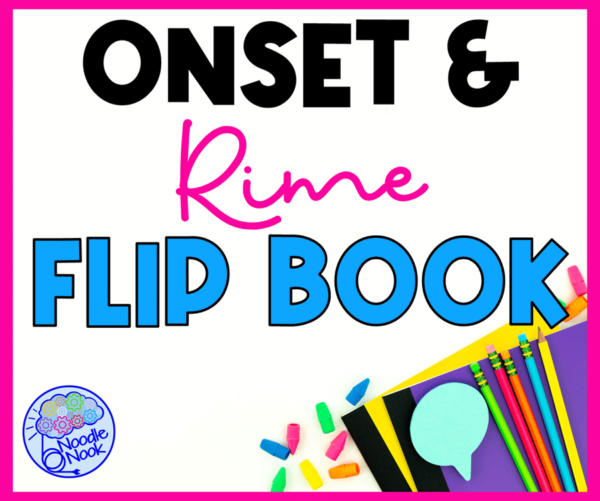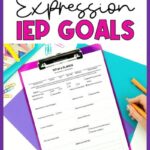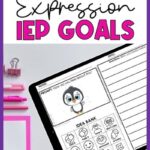It’s not uncommon for special education students to have reading IEP goals set out by the IEP team. Reading is an essential skill. Where we often drop the ball as a special education teacher is focusing as much time and effort on writing IEP goals. When a child struggles with reading, they often struggle with written expression. An important first step in focusing in on the specific skills associated with reading is to write companion written expression IEP goals.
What are Written Expression IEP Goals?
Written expression goals refer to specific objectives that students with special needs aim to achieve in the area of written communication. These goals are designed to address the student’s individual needs and abilities as part of their Individualized Education Program (IEP).
Written expression goals can cover various aspects of writing, such as grammar, vocabulary, sentence structure, paragraph development, organization, and coherence. The goals can be short-term or long-term. They should be measurable, achievable, relevant, and time-bound (see below). The goals are developed collaboratively by the student, parents, educators, and other professionals on the IEP team. They monitor and adjust those goals as needed to ensure that the student makes progress toward achieving them.
Why Write Written Expression IEP Goals?
Whether it’s writing an essay, taking notes, sending an email, or communicating in the workplace, the ability to write is essential. Being able to write as a functional skill can improve all aspects of postsecondary life. That includes independent living, employability, and social skills. On top of that, writing skills support all content areas. They allow a student to express their ideas on any given subject.
Written expression IEP goals should go hand in hand with reading goals in a child’s IEP. The National Reading Panel outlines the pillars of reading. They include phonemic awareness, phonics, fluency, vocabulary, and comprehension. I think writing should accompany that.
If a student struggle with reading, they likely struggle with writing too. Coupling instructional goals in this manner is a good educational practice since the two skills go hand in hand. A student that doesn’t master phonics likely struggles with spelling during writing assignments. Likewise, a student that has difficulty learning phonic skills or has weak phonemic awareness skills may also lack the necessary components needed to write successfully. Systematic instruction focused on writing is how you build better writing skills. An unintended consequence is building better reading skills.
The Form and Function of Writing
Written expression IEP goals are goals that support a student’s ability to write. Remember, though, that this is a goal based on the function of writing, not the form of writing. In other words, it’s about the process of conveying one’s thoughts and ideas in writing. Goals about the form of writing, like properly holding a pencil or forming letters, is more about the student’s physical abilities, not cognitive skills.
For many students with complex access needs, the task of writing is a challenge. Beyond the many physical and sensory issues that make writing difficult, there are disability related hurdles too. Students may have learning and attention issues, memory and recall deficits, and problems organizing information. This makes written expression a challenging task. That’s why IEP goals that focus on the function of written expression are crucial. As is providing individualized support and instruction to help students improve their writing skills.
When Do We Write These IEP Goals?
IEP goals for written expression are typically written as annual goals. This is during the IEP development process for students with disabilities who qualify for special education services. The IEP team includes parents, educators, specialists, and the student (when appropriate). They meet to discuss the student’s strengths, weaknesses, goals, and progress in various areas, including written expression. Based on the student’s needs and abilities, the team identifies specific areas of writing that require improvement and sets individualized goals.
The goals should be designed to help the student make progress toward grade level standards. They should also address the student’s functional needs in daily life. The goals should also be appropriate for the student’s age, grade, and disability. They should consider the student’s learning style, interests, and preferences. Once the goals are written, the team discusses the instructional strategies, accommodations, and services that will support the student in achieving the goals and documents them in the IEP. Lastly, the team reviews the goals and the student’s progress toward them regularly. They should then adjust them as needed to ensure that the student makes progress toward achieving them.
SMART & Measurable Goals
SMART goals are Specific, Measurable, Achievable, Relevant, and Time-bound. SMART IEP goals are important because they provide clarity, motivation, accountability, and a clear framework for evaluating progress toward the goal. They help to ensure that the goals are relevant and achievable for the student. They also help to make sure instruction and supports are effective in helping the student achieve the goals.
Drafting measurable IEP goals is essential. Those are goals that can be quantified or observed. That makes tracking and evaluating progress toward the goal easier. Rubrics make a great grading tool. It’s an objective way to measure performance and progress in a consistent manner. Then it’s easier to determine if the student is developing specific skills as an intended outcome of instruction and if the outlined educational program is effective. If not, then it’s easier to adjust the instruction and supports in a meaningful way.
Strategies for Setting Written Expression IEP Goals
Setting effective written expression IEP goals requires careful consideration of the student’s needs, abilities, and interests. Here are some strategies for setting written expression IEP goals:
- Use assessment data: Assessments can provide valuable information about the student’s strengths and weaknesses in writing. Use the data to identify specific areas of writing that require improvement. Then use it to set measurable goals that address those areas.
- Collaborate with the student: Involve the student in the goal-setting process as much as possible. Ask the student about their writing strengths and weaknesses, interests, and preferences, and use their input to set goals that are relevant and achievable.
- Use SMART criteria: Set goals that are specific, measurable, achievable, relevant, and time-bound. This will keep the goals clear, focused, and relevant to the student’s needs.
- Consider the writing process: Set goals that address various stages of the writing process. That includes planning, drafting, revising, and editing. This will help the student to have a comprehensive understanding of writing and is able to produce high-quality written work.
- Use visual models and graphic organizers: Provide visual models and graphic organizers. This can help the student understand the structure and organization of written work. This can be particularly helpful for students with learning and attention issues.
- Use informal assessments: Use informal assessments to monitor the student’s progress towards the goals and to adjust instruction and supports as needed. This can help ensure progress is being made toward the goals and that the goals remain relevant and achievable.
By using these strategies, educators and IEP teams can set effective written expression goals that are tailored to the student’s needs and abilities, and that help the student develop the skills needed to succeed in academic and personal settings.
Areas of Focus with Written Expression IEP Goals
When setting written expression IEP goals, it’s important to consider the specific areas of writing that require improvement. Here are some areas of focus to consider:
- Sentence structure and syntax: Set goals that address the student’s ability to write complete sentences with proper syntax and grammar. This can include goals related to sentence variety, subject-verb agreement, punctuation, and capitalization.
- Paragraph structure and organization: Set goals that address the student’s ability to organize their writing into coherent paragraphs with a clear topic sentence and supporting detail sentences. This can include goals related to clear main ideas, transitions, paragraph length, and the use of graphic organizers.
- Word usage and vocabulary: Set goals that address the student’s ability to use appropriate and varied vocabulary in their writing. This can include goals related to word choice, the use of descriptive language, and the use of word lists and dictionaries.
- Writing style and tone: Set goals that address the student’s ability to write with a clear and appropriate style and tone. This can include goals related to the use of figurative language, the use of dialogue, and the development of a personal voice.
- Written composition and essay assignments: Set goals that address the student’s ability to write longer, more complex pieces of writing, such as essays and research papers. This can include goals related to research skills, thesis development, and the use of sources.
By focusing on these areas, educators and IEP teams can set goals that are specific, measurable, and relevant to the student’s needs, and that helps the student develop the skills needed to produce high-quality written work.
Ideas for Written Expression IEP Goals
Examples of written expression goals include writing a complete sentence, constructing a five-sentence paragraph, developing a thesis statement, using transition words, revising and editing one’s work, and writing an essay on a given topic. Here are five examples of written expression IEP goals that can help students improve their writing skills. Use these as models for your personal goal bank as you work to collect sample IEP goals for writing.
- Example Goal #1: By the end of the school year, given a writing assignment, the student will write a five-sentence paragraph with transition words and detailed sentences, in 80% of opportunities, as measured by teacher observation.
- Example Goal #2: By the end of the first semester, given a writing assignment, the student will write a complete sentence with correct capitalization and punctuation, with no more than two errors, in 90% of opportunities, as measured by a writing rubric.
- Example Goal #3: By the end of the second semester, given a writing assignment, the student will write a paragraph with a clear main idea and at least two key details, in 80% of opportunities, as measured by teacher observation and a writing rubric.
- Example Goal #4: By the end of the school year, given a writing assignment, the student will use appropriate vocabulary words and descriptive language to write a complete sentence with a clear subject-verb agreement, in 80% of opportunities, as measured by teacher observation and a writing rubric.
- Example Goal #5: By the end of the second quarter, given a writing assignment, the student will use a graphic organizer to plan and organize a written composition with a clear main idea, at least three supporting details, and a logical organizational structure, in 80% of opportunities, as measured by teacher observation and a writing rubric.
Special education teachers as well as the IEP team need to start with a good IEP goal. Ideally, you should be able to gather objective data to track the goal. You may also want to consider the supports you set out in as part of the condition of the goal. That could include a word list, a sample sentence or sentence starters, of set the goal for a specific number of sentences in the writing sample. Personalize the student’s goals and be sure they are achievable goals. And remember, these are example IEP goals, not an exhaustive goal bank.
Implementing and Monitoring Written Expression IEP Goals
Implementing and monitoring written expression IEP goals is essential to ensure that students are making progress toward their goals. Here are some strategies that educators and IEP teams can use to implement and monitor written expression IEP goals:
- Regular progress monitoring: It’s important to regularly monitor the student’s progress toward their written expression goals. This can be done through regular writing assignments, teacher observations, and assessments. The data collected from progress monitoring can help educators make informed decisions about the student’s writing instruction and support. Remember to use short-term steps and objectives that support a larger goal.
- Provide accommodations and modifications: Students with written expression difficulties may benefit from accommodations and modifications, such as extended time, use of a word processor, or the use of graphic organizers. Graphic organizers are a great visual model to help students process information. Providing these accommodations and modifications can help students access the writing curriculum and make progress toward their goals.
- Deliver targeted instruction: Students with written expression difficulties may need targeted instruction to help them develop specific writing skills. This can include direct instruction on sentence structure, paragraph organization, or vocabulary development. Providing targeted instruction can help students develop the skills they need to achieve their written expression goals.
- Provide feedback: Providing timely and specific feedback to students on their writing can help them improve their skills and make progress toward their goals. Feedback can be provided through teacher conferences, peer review, or written comments.
By implementing and monitoring written expression IEP goals using these strategies, educators and IEP teams can help students develop the skills they need to succeed in academic and personal settings.
RECAP: Written Expression IEP Goals
Writing is a fundamental skill that can greatly impact a student’s academic and personal success. Setting effective written expression IEP goals is crucial to help students with writing difficulties make progress in their academic and personal lives. SMART and measurable goals, set collaboratively with the student and their support team, can help guide instruction and provide a clear target for progress monitoring. Strategies such as regular progress monitoring, accommodations and modifications, targeted instruction, and feedback can help implement and monitor written expression IEP goals.
With a focus on specific areas of writing skills such as sentence structure, paragraph organization, and vocabulary development, students can improve their writing skills and achieve success in their academic and personal lives. That all starts with a great writing goal that targets essential skills and is backed in educational research. And writing matters.

